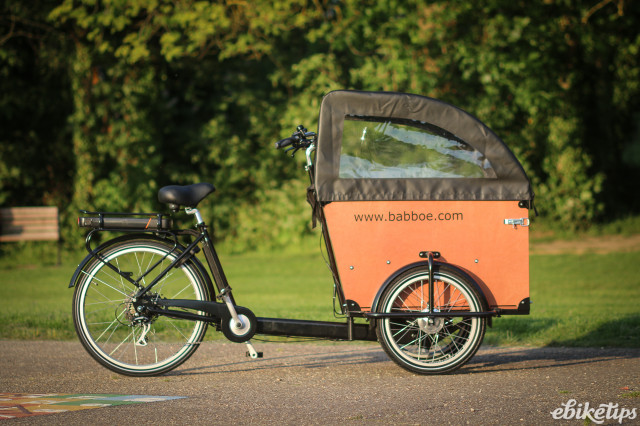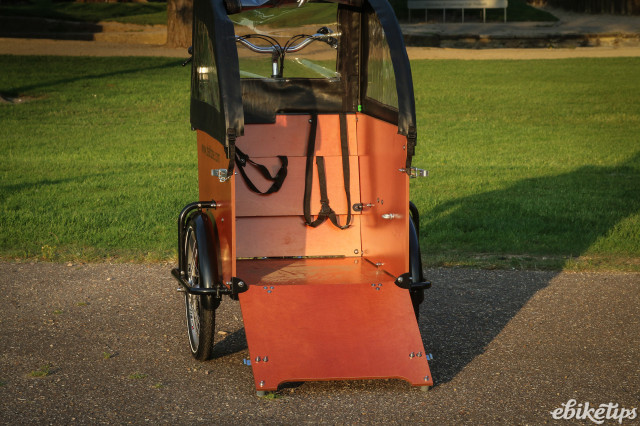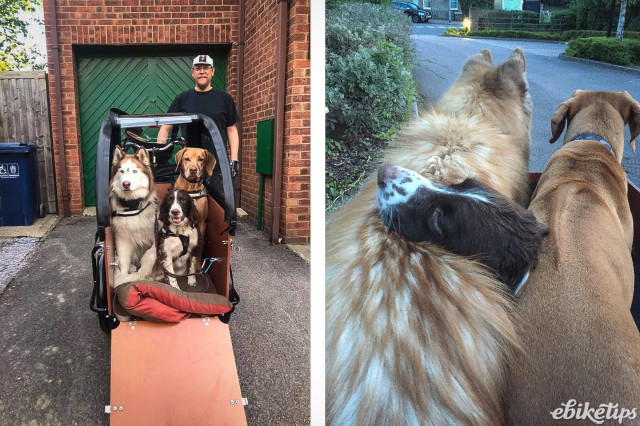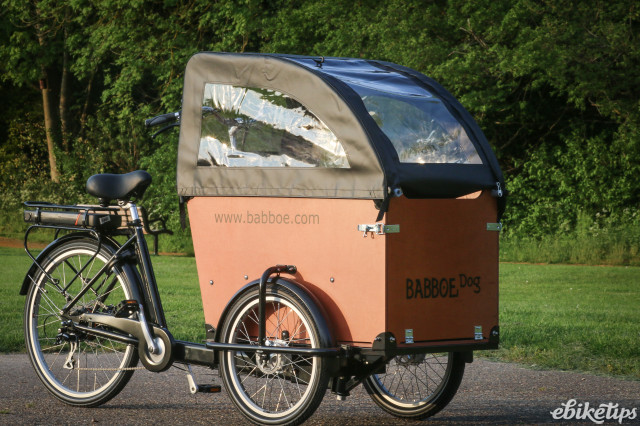Babboe Dog-E

Overview
- Lots of fun for extroverts and show-offs
- Dogs love it too
- Versatile carrier of kids, dogs & shopping
- Needs wider gears
- Struggles on hills
- 'Interesting' handling
Babboe’s Dog-E is a rare and unusual critter: an electric-assist cargo bike specifically tailored for transporting dogs rather than the usual kids or freight. And — with a few caveats — it works really well as long as you keep in mind its limitations as a short-trip vehicle.
Buy the Babboe Dog-E here
The Dog-E is based on Babboe’s Big-E, and if we’re going to be pedantic these are cargo trikes rather than bikes with two wheels up front to support a big plywood cargo box.
The differences between the two are in the details of the box. The Big-E’s box is a conventional big wooden container. There are benches inside for up to four kids but your passengers are expected to clamber aboard. Being juvenile hairless apes they’ll have no problem with that.
Not having spent any evolutionary time in the trees, dogs aren’t good at clambering, so the Dog-E has a drop-down door-cum-ramp at the front. You unlatch it, fold it down and your dog or dogs just stroll in. Once they’re aboard there are sturdy metal rings to attach leads so they’re somewhat discouraged from trying to get out.
There’s a 100kg load limit, so that’s one Great Dane, Newfoundland or mastiff; two, three or even four sensible sized dogs; or about 30 Chihuahuas. Astra the ridgeback, Flash the husky and Lyra the springer spaniel come to about 75kg and soon worked out who was going to stand or sit where.
Ride and handling
With the pack loaded up and secured, off we went...
Riding the Dog-E is a ton of fun. It helps if you enjoy being the centre of attention, because you get grinned at by everyone who sees you and your pack. There’s just something about a dog on a bike that makes people smile – triply so if it’s three dogs in a battery-assisted behemoth.
The most important thing you need to know about the Dog-E’s handling is that, electric assist or not, the Babboe Dog-E does not handle like a bicycle. Trikes just don’t, and that takes a bit of getting used to. Instead of leaning and initiating a turn from torso and hips, a trike has to be actively steered the way you want it to go. It’s far more like a car than a bike.
This isn’t difficult, it’s just different, and you soon get the hang of it at lower speeds. As well as needing deliberate steering, a trike is affected by the road camber and you really notice potholes and bad surfaces as they shake you and your cargo from side to side as well as up and down. This bothered me far more than it bothered the dogs, who just put up with it.
The next handling surprise comes when you try and take a corner at anything much over 10mph. You need to shift your weight toward the inside wheel to keep everything steady and on track, otherwise it understeers and you go veering off into the opposite lane.
Unladen cornering is even more interesting – the first time I took a corner at speed on the way to Sainsbury’s I lifted the inside wheel and had to hastily swing my bum off the saddle and into the corner to get it back down again... lesson learned.
Most of this was a matter of re-educating my reflexes, and I mention it here simply so you’re prepared if you decide a trike like this is the right electric-assist vehicle for your needs.
The dogs were entirely unfazed by all this, and when my partner’s 17-year-old needed picking up from the station she pronounced the passenger experience as “fun”.
One disadvantage of a trike is that it’s wide. At 88cm from edge to edge the Dog-E dominates many bike tracks and is very nearly too wide for some of Cambridge’s narrower cycling facilities. Some gates and even doorways are just too narrow for it; and it only just fits on the bridge where a local cycleway crosses a stream. Measure twice before buying.
The Dog-E’s QWIC rear hub motor has six power-assist settings, that range from “barely helping” to “wheeeee!”, plus a walk-assist mode.
Without the electric assist, the Dog-E would be barely usable even lightly laden. It’s frankly a bit of a monster, though it’s hard to see how it could be otherwise without tripling the price. Dial up the power assist and it comes alive, zipping along with the rear hub motor humming softly to itself.
With the motor in the rear hub, there’s a delay of about half a pedal revolution before the electronics realise you’re pedalling and kick in the power. That can make pulling away from junctions a bit tricky if you’ve rocked up in a high gear. Hitting the walk-assist button helps you get started, but it’s far better to anticipate and change gear.
The 374Wh battery is good for about 25 miles at moderate assist levels before range anxiety sets in. Babboe’s upper estimate of 37 miles seems a bit optimistic unless you’re going to ride the Dog-E unladen, and what would be the point of that?
Some e-bikes will sail up hills at 10-15mph on full assist, but on a 10 percent grade, and pedalling hard to help out, I hit about 6mph. That’s not terribly surprising given the Dog-E’s laden weight, and in fact it’s a solid argument for electric-assist on cargo bikes. With the dogs on board I doubt I’d be able to get up a slope like that at all without completely changing the gearing; there’s a reason why old butcher’s bikes and the like had very low gears.
Babboe tacitly admits that its rear-wheel motor is a bit gutless for hillier terrain. In its description of the Curve-E cargo bike, Babboe said: “Do you cycle over hills with a gradient of 3% or more? Then we advise the Babboe Curve Mountain.”
The Mountain versions that Babboe offers of some models have high-torque mid-engines to better handle hills, but there isn’t a Dog-E Mountain. That’s a pity, because a motor with more torque might help get the Dog-E up hills and away from the lights with a bit more oomph.
On the flat or downhill the motor cuts out gradually at slightly over the legislated 15.5 mph. I usually find myself wishing that rule gave us another few miles per hour, but I was quite happy not to be trying to wrangle the Dog-E at 20mph while pedalling.
I did hit 30mph coasting on a couple of downhills. At this sort of speed you initially feel like you should death-grip the handlebar to maintain control, but that’s actually a bad idea because it impedes the hydraulic steering dampers under the box. Instead, you grip moderately firmly but keep your arms relaxed so the steering can wobble a little, and trust the steering dampers to keep everything on track. It works.
Components
With seven-speed Shimano derailleur gearing and cable-actuated brakes, the Dog-E’s bike components are basic but functional.
The gears could do with a much wider range than is provided by the 14-28 seven-speed freewheel and 32-tooth chainring. It’s adequate for completely flat terrain, but even in Cambridge we do have the odd hill and I wanted to be able to take it easier on some climbs and keep up with the bike on descents. As it stands, the overall gearing requires you to pedal at 90rpm to keep up with the bike at the maximum assisted speed of 15.5 mph, which feels distinctly odd on an upright bike. A simple substitution would be a SunRace or Shimano 13-34 seven-speed freewheel; an 11-32 eight or nine speed with a smaller chainring, say a 30 or even 28-tooth, would be even better.
Stopping power comes from an Avid BB-7 disc brake out back and a pair of Sturmey-Archer drums up front. The front brakes are actuated by the right-hand lever with a splitter to get the cable tension to both brakes. The splitter needs careful set up to get even braking; get it wrong and it pulls to one side. The front brake lever can be locked so it acts as a parking brake, which is extremely useful.
This is clearly an area where the budget has limited the equipment fitted. Hydraulic disc brakes would be significantly better, but splitting a hydraulic line to actuate two brakes would be tricky and expensive.
Accessories and modifications
Babboe offers various accessories for the Dog-E including anti-slip mats for the base and door. These should be part of the package, even if that puts the price up, as the plywood door and base are fairly slippery.
MyDog-E came with the optional rain cover, which I wanted mostly to discourage the dogs from trying to jump out. It helps with this, but not as much as keeping them on short leashes and being ready to just grab them if a deer jumps out in front of you.
I often found myself wanting a reverse gear. I’m not criticising Babboe for failing to provide one; as far as I know, no cargo e-bike maker does, but by crikey it’d be handy for getting the Dog-E up my drive and into the garage ready for next time.
Being Dutch, Babboe fits inner tubes with Woods valves to the Dog-E. I swapped them for sealant-filled Schrader valve tubes. Fixing a flat in the field when all the wheels are bolted on and the rear has a load of electronic gubbins as well as the chain is a pain I wanted to avoid.
Updates
I’ve been using a 2019 Babboe Dog-E; there have been a few changes for the 2020 model, which has been available since the summer. Babboe now uses a GWA battery and motor, which should provide a bit more oomph than the QWIC system, and has eight levels of assist rather than six. The rear rack has been beefed up, and there are now LED front lights powered from the battery pack as well as a rear light.
Nevertheless, there are circumstances where even the new version struggles. Former road.cc news reporter Sarah Barth recently got a 2020 Babboe Big-E to transport her toddler. Sarah’s most direct route to her kid’s daycare involves a 13% hill. “I got up it, but it was really, really hard,” she says. That tallies with Babboe’s advice to get a Mountain if you ride hills of course.
Conclusion
The Babboe Dog-E is a mixed bag. On the one hand, it’s a lot of fun to ride. You don’t have many choices if you want a specific dog-transporting e-bike anyway, so it’s good news that the Dog-E performs its role plenty well enough. The dog-specific aspects are well-executed; the dogs easily get in and out, and the sturdy rings provide secure attachment for leads. And the grin factor is off the scale; don’t buy a Dog-E if you want to be ignored!
But I did get a bit frustrated when banged up against the compromises Babboe has made to keep the price under two and a half grand. I’d have really liked a much wider gear range, and hydraulic disc brakes all round would make it easier to tame a fully-laden Dog-E’s weight. Those changes would probably add a couple or three hundred quid to the price, but when you’re already looking at spending £2,400 is that buying decision really that price-sensitive?
Overall, though, if you’ve got dogs to transport, and you live somewhere fairly flat, then the Dog-E is a solid choice that does the job well.
















